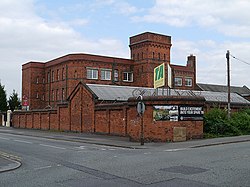Second Boer War
After the disasters of Black Week at the start of the Second Boer War in December 1899, most of the regular army was sent to South Africa, followed by many militia reservists as reinforcements. Militia units were embodied to replace them for home defence and a number volunteered for active service or to garrison overseas stations. [38] [39] [40] One of the first embodied was the 3rd South Lancashires, on 3 December 1899, and the battalion embarked for South Africa on 10 January 1900, with a strength of 24 officers and 703 other ranks (ORs) under the command of Lt-Col Robert Ireland Blackburne, son of the unit's first colonel. [20] [24] [26]
The battalion arrived at Cape Town on 13 February 1900. At that time the operations to relieve the Siege of Kimberley were reaching a climax and reinforcements were being rushed to the front by rail and forced marches: 3rd South Lancashires was immediately sent up. Battalion Headquarters (HQ) and the left half-battalion went up to Naauwpoort, but the right half, following on a day behind, was stopped at Hanover Road on 17 February to meet an expected Boer attack. The rest of the battalion then came back in support, the aim being to prevent the Boers cutting the Naauwpooer–De Aar railway that provided the army's main Line of communications. Major Alexander Tarbet was posted with three companies at the Diamond Mine Kopje to guard against an attack from the east. The force at Hanover Road stood to at daybreak on 18 February, with 1500 Boers with six guns being reported nearby. During the day the South Lancs were reinforced by about 50 Royal Engineers and 100 mounted troops, and dug entrenchments to cover the town and the bridge over the river. By now the relief of Kimberley had led to the Battle of Paardeberg (18–27 February), and on 21 February the 3rd South Lancs went out to cover the successful attempt by the Victorian and Tasmanian Mounted Rifles to break through to Arundel. [26] [41]
After Paardeberg, the battalion moved up, HQ and Left Half to Rensburg, Right Half to Arundel, and thereafter it generally operated in these two halves. On 20 March they moved to Colesberg Junction and Colesberg respectively, then were briefly reunited at Norvalspont on 21 April. Right Half was then sent to the north bank of the Orange River while HQ and Left Half remained on the south, providing outpots of the surrounding kopjes and providing working parties to help repair the railway bridge. On 25 April Lt-Col Blackbune was invalided (he did not return for seven months) and the command devolved on Maj Montague Hall. Major Tarbet remained in command on the south bank when HQ crossed on 27 May and moved into 'Lancashire Fort' and the other defences on that side. On 1 August part of the battalion moved to Springfontein, followed by HQ and the rest of the battalion. [26]
At the beginning of October there were indications that the Boers were moving south, and on 6 October parties were sent out to protect the railway north and south of Springfontein. Some parties were fired on, and next day the commandant of Springfontein took out about 10 men of the 3rd South Lancs under Maj Tarbet and Capt Vaughan, with a howitzer section of 87th Battery, Royal Artillery, and some Mounted infantry (MI) to destroy Pretorius's Farm. On 13 October two patrols from the battalion's MI company at Jagersfontein converged on another farm house known to be frequented by the Boers and came under fire, suffering some casualties. Jagersfontein itself was then summoned to surrender by Commandant Pretorius, but Maj Tarbet brought up reinforcements and took command. The MI Company continued to defend Jagersfontein and Fauresmith. From 13 October to 6 November there were nightly attacks on the railway, which had to be repaired by working parties, and the trenches were occupied each night. On 25 October an attempt against the Knilfontein bridge was repelled after a short fight. On 11 November D Company at Kruger's Siding was summoned to surrender by Commandant Gideon Scheepers and was attacked but the Boers were driven off by two companies of the Grenadier Guards and an armoured train. [26]
Battalion HQ remained at Springfontein until July 1901. Lieutenant-Col Blackburne returned to the command on 23 November and shortly afterwards Maj Hall took over as commandant of the town. During the hunt for Christiaan de Wet in February 1901, the 3rd South Lancs captured his scout crossing the railway between Springfontein and Jagersfontein, and on 9 February De Wet's column was engaged by the MI from Jagersfontein and an armoured train as it crossed the railway 6 miles (9.7 km) north of Springfontein. Shortly afterwards a 45 miles (72 km) line of blockhouses was built along the line, which proved impenetrable to the Boer Commandos; none of these posts was ever lost by the South Lancs. [26] [42]
The battalion was relieved and left Cape Town for England on 3 July 1901, arriving home on 2 August. It was disembodied the next day. For its service the battalion was awarded the Battle honour South Africa 1900–01 and all the participants received the Queen's South Africa Medal with the clasps for 'Cape Colony', 'Orange Free State' and 'South Africa 1901'. Lieutenant-Col Blackburne was awarded a CB and Majors Hall and Tarbet each received the DSO. [24] [26] [25]

